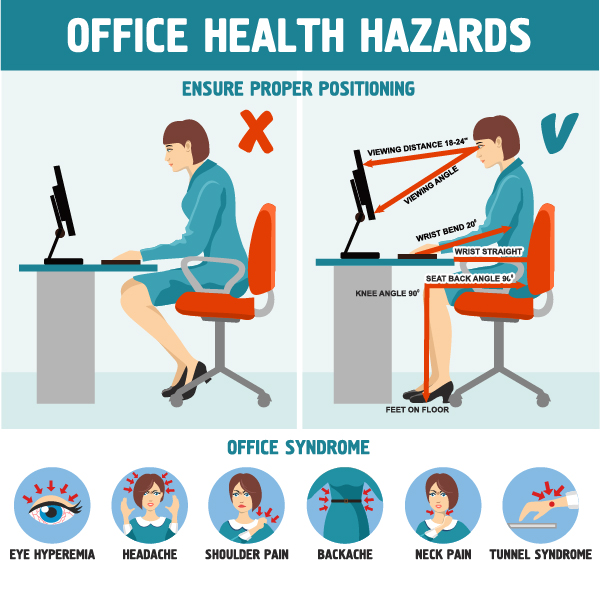If current conditions have resulted in you working from home, you may be struggling to get comfortable. Literally.

A lot of modern work involves sitting in front of a computer for hours on end. For many reasons, this isn’t good for us — particularly if we don’t have a well thought-out home office space. Working from home may be (physically) hurting you, but here are some ways to optimize your home office ergonomics to help you avoid those injuries. Applying these small changes can prevent, or even reverse, chronic pain issues you could be experiencing.
How work hurts
Many of us experience back and neck pain after a particularly long or intense day at work. Some get numbness or tingling in the hands and forearms. Several studies have shown the correlations between sitting at a desk for a long period of time and chronic back pain. These are some conditions that can result from poor office ergonomics:
- Back pain caused by injuries to the muscles, joints, or discs
- Carpal tunnel syndrome (median nerve entrapment at the wrist)
- TMJ dysfunction and tension headaches
- Cervical strain and pain (including a new phenomenon called “text neck”)
- Tendonitis (inflammation in tendons)
- Rotator cuff strains and tears
- Bursitis (bone, tendon, ligament or muscle swelling)
- Trigger finger (finger gets stuck in a bent position)
Why work hurts
Most injuries that happen at work are caused by physical stress and strain. Sitting in the same position for a long time, making repetitive movements, and overuse can lead to pain gradually over time. These actions make up the basis of home office work and can be inherently problematic for our bodies.
Understanding what might be causing our pain is a necessary first step to correcting the problem. Having poor posture is often the culprit: whether we’re slumped on the couch, propped up in bed, or sitting at a table that’s too tall for ergonomic keyboard typing. Not only are we repeating the same movements over and over again, but we may be doing them with poor alignment, causing additional strain.
Improving how we work at home
Good office ergonomics can help help lower stress and injury caused by awkward positioning and repetitive tasks while working from home. It may just take making some simple adjustments. Below are recommendations from Dr. Joel Peck, Director of Physical Therapy at Great Basin Orthopaedics, on optimizing any work space.
Posture is everything
- Sit tall and straight to maintain three curves in the back — neck, upper and lower back
- Keep feet flat, even and don’t cross your legs
- Forearms should be supported by the desk/work surface or chair arms
The chair matters
You don’t need a million-dollar office chair to have good ergonomics. You just need a chair that enables you to maintain good posture and Dr. Peck’s “rule of 90s.”
- Chair height should enable you to have feet flat and knees at 90˚ — you can use a footrest to adjust for this
- Maintain 90˚ at the hips and elbows
- If the chair doesn't support your lower back's curve, place a rolled towel or small pillow behind your lower back
Consider your ‘desk’
Some of us started working from home suddenly without a dedicated space. If you are improvising your workspace, you can still make good ergonomic choices whether you’re sitting at an Ikea LINNMON or a piece of plywood on two sawhorses.
- Use a stable work surface at the right height to maintain correct posture
- Your lap is rarely a good position for a computer but is improved by use of a lap desk
- Laying on a bed or the floor to work on the computer strains your neck and lower back
Get the height right
When computer screens are too low, they cause the user to tilt their head down which misaligns their spines. (Consider this next time you bring the i-Pad to bed to watch a movie). As most screen are not height adjustable, you may need to use some large books, wood blocks or an adjustable monitor stand.
- Place computer screen at eye height when sitting with good posture
Reach with care
Items like your telephone and frequently referenced papers should be easy to grab. You want to minimize any awkward twisting or reaching as it can strain your spine and joints.
- Keep most frequently used objects close by on your work surface
- Stand up to get anything that can't be comfortably reached while sitting
Get up
Prolonged sitting just isn’t healthy. Dr Peck recommends setting a timer at regular intervals to ensure you get up and move regularly, even if just for a few minutes. Because you’re at home, you can use these breaks to be productive by throwing in a load of laundry, walking the dog or watering the garden.
- Get up from your desk every 20-30 minutes
Whether you love working from home or are just toughing it out until you can return to the office, creating a safe and physically supportive workspace is important. It will make you more comfortable and might event prevent injury and development of chronic pain.
If you are continuing to struggle with bone or joint pain, see a specialist at Great Basin Orthopaedics for an evaluation. Their team of surgeons and physical therapists are ready to help — and most appointments can be scheduled within a week. Call 775.786-1600 to schedule your consultation.